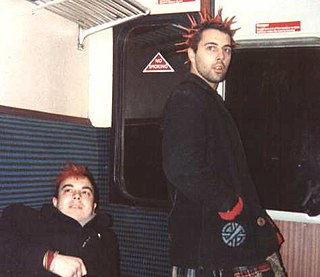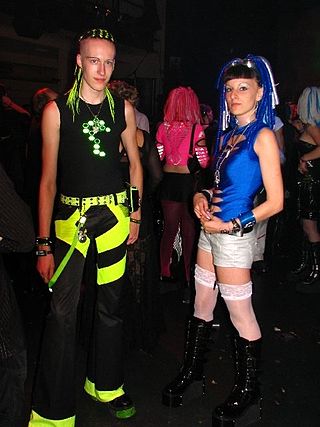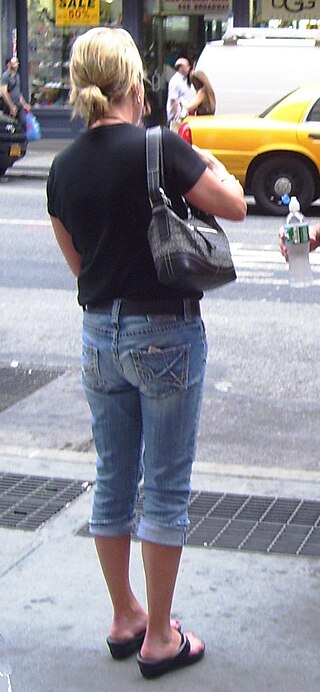
Gothic fashion is a clothing style worn by members of the goth subculture. A dark, sometimes morbid, fashion and style of dress, typical gothic fashion includes black dyed hair and black clothes. Both male and female goths can wear dark eyeliner, dark nail polish and lipstick, and dramatic makeup. Styles are often borrowed from the Elizabethans and Victorians. BDSM imagery and paraphenalia are also common. Gothic fashion is sometimes confused with heavy metal fashion and emo fashion.

Fetish fashion is any style or appearance in the form of a type of clothing or accessory, created to be extreme, revealing, skimpy, or provocative in a fetishistic manner. These styles are by definition not worn by the majority of people; if everyone wears an item, it cannot have fetishistic, special nature. They are usually made of materials such as leather, latex or synthetic rubber or plastic, nylon, PVC, spandex, fishnet, and stainless steel. Some fetish fashion items include: stiletto heel shoes and boots, hobble skirts, corsets, collars, full-body latex catsuits, stockings, miniskirt, crotchless underwear, jockstraps, diapers, garters, locks, rings, zippers, eyewear, handcuffs, and stylized costumes based on more traditional outfits, such as wedding dresses that are almost completely see-through lace, or lingerie for men.

Punk fashion is the clothing, hairstyles, cosmetics, jewellery, and body modifications of the punk counterculture. Punk fashion varies widely, ranging from Vivienne Westwood designs to styles modeled on bands like The Exploited to the dressed-down look of North American hardcore. The distinct social dress of other subcultures and art movements, including glam rock, skinheads, greasers, and mods have influenced punk fashion. Punk fashion has likewise influenced the styles of these groups, as well as those of popular culture. Many punks use clothing as a way of making a statement.

Heavy metal fashion is the style of dress, body modification, make-up, hairstyle, and so on, taken on by fans of heavy metal, or, as they are often called, metalheads or headbangers. While the style has changed from the 1970s to the 2020s, certain key elements have remained constant, such as black clothes, long hair and leather jackets. In the 1980s, some bands began wearing spandex. Other attire includes denim or leather vests or jackets with band patches and logos, t-shirts with band names, and spiked wristbands.

Hip-hop fashion refers to the various styles of dress that originated from Urban Black America and inner city youth in cities like New York City, Atlanta, and Los Angeles. Being a major part of hip hop culture, it further developed in other cities across the United States, with each contributing different elements to the overall style that is now recognized worldwide.

Bell-bottoms are a style of trousers that become wider from the knees downward, forming a bell-like shape of the trouser leg.
A rivethead or rivet head is a person associated with the industrial dance music scene. In stark contrast to the original industrial culture, whose performers and heterogeneous audience were sometimes referred to as "industrialists", the rivethead scene is a coherent youth culture closely linked to a discernible fashion style. The scene emerged in the late 1980s on the basis of electro-industrial, EBM, and industrial rock music. The associated dress style draws on military fashion and punk aesthetics with hints of fetish wear, mainly inspired by the scene's musical protagonists.

Cybergoth is a subculture that derives from elements of goth, raver, rivethead and cyberpunk fashion.
Wide-leg jeans, colloquially called baggy pants, are a style of clothing popular from the early 1980s to the 2010s. And again in the 2020s.

Fashion in the 1990s was defined by a return to minimalist fashion, in contrast to the more elaborate and flashy trends of the 1980s. One notable shift was the mainstream adoption of tattoos, body piercings aside from ear piercing and, to a much lesser extent, other forms of body modification such as branding.
Japanese street fashion refers to a number of styles of contemporary modern clothing in Japan. Created from a mix of both local and foreign fashion brands, Japanese street fashions tend to have their own distinctive style, with some considered to be extreme and imaginations, with similarities to the haute couture styles seen on European catwalks.

Fashion of the 1980s was characterized by a rejection of 1970s fashion. Punk fashion began as a reaction against both the hippie movement of the past decades and the materialist values of the current decade. The first half of the decade was relatively tame in comparison to the second half, which was when apparel became very bright and vivid in appearance.
Phat pants, phatties, or phats are a style of pants that are fitted at the waist, but get increasingly wide down the legs, covering the feet entirely due to their width. Phat pants can be made out of a variety of materials, however denim, faux fur, and cotton fabric tend to be the most common. High-end customized phats tend to include UV reflective tape decoration to add a glowing effect. Phat pants are notable for being a visual identifier of those within the rave community. Popular makers of phat pants include Kikwear, UFO, Q-ambient, and JNCO.

The fashion of the 2000's is often described as a global mash up, where trends saw the fusion of vintage styles, global and ethnic clothing, as well as the fashions of numerous music-based subcultures. Hip-hop fashion generally was the most popular among young people of both sexes, followed by the retro inspired indie look later in the decade.

Pedal pushers are calf-length trousers that were popular during the 1950s and the early 1960s. First seen as Knickerbockers or "knickers", they were baggy trousers that extended to or just below the knee and were most commonly fastened with either a button or buckle. Knickerbockers were initially worn by men in the late 19th century and over time became part of women's fashion. Often cuffed and worn tight to the skin, they are related in style to capri pants, and are sometimes referred to as "clam diggers". The name "pedal pushers" originated from the style originally worn by cyclists, because long pants can catch in bicycle chains, but the style quickly became identified with teenage girls.

Fashion in the 1970s was about individuality. In the early 1970s, Vogue proclaimed "There are no rules in the fashion game now" due to overproduction flooding the market with cheap synthetic clothing. Common items included mini skirts, bell-bottoms popularized by hippies, vintage clothing from the 1950s and earlier, and the androgynous glam rock and disco styles that introduced platform shoes, bright colors, glitter, and satin.

Slim-fit pants or skinny jeans are tight trousers that have a snug fit through the legs and end in a small leg opening that can be anywhere from 9" to 20" in circumference, depending on size. Other names for this style include drainpipes, stovepipes, tight pants, cigarette pants, pencil pants, skinny pants, gas pipes, skinnies, and tight jeans.
Alternative fashion or alt fashion is fashion that stands apart from mainstream, commercial fashion. It includes both styles which do not conform to the mainstream fashion of their time and the styles of specific subcultures. Some alternative fashion styles are attention-grabbing and more artistic than practical, while some develop from anti-fashion sentiments that focus on simplicity and utilitarianism.

The 2010s were defined by hipster fashion, athleisure, a revival of austerity-era period pieces and alternative fashions, swag-inspired outfits, 1980s-style neon streetwear, and unisex 1990s-style elements influenced by grunge and skater fashions. The later years of the decade witnessed the growing importance in the western world of social media influencers paid to promote fast fashion brands on Pinterest and Instagram.

Mall goths are a subculture that began in the late-1990s in the United States. Originating as a pejorative to describe people who dressed goth for the fashion rather than culture, it eventually developed its own culture based around nu metal, industrial metal, emo and the Hot Topic store chain. It has variously been described as a part of the goth subculture, as well as a separate subculture simply influenced by goth.
















